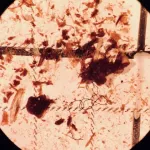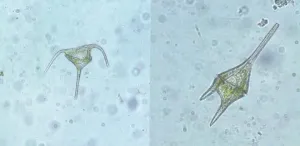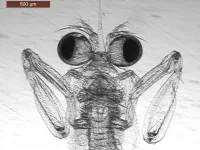(Press-News.org) As part of a laboratory experiment, Rebecca Holmes examined water bottles that had been acquired from abroad expecting to find bisphenol A (BPA), a human-made component commonly found in polycarbonate plastics used to make consumer products.
What she found, however, was that those water bottles were just fine, yet some control bottles purchased in the United States and supposedly BPA-free actually contained traces of the chemical now thought to negatively impact heart health.
Holmes, a researcher formerly in the laboratory of Hong-Sheng Wang, PhD, professor in the University of Cincinnati Department of Pharmacology and Systems Physiology, was working on her master's degree in molecular, cellular and biochemical pharmacology in the College of Medicine at the time.
"We believed that it likely was BPA contaminant on the surface of the bottle," says Holmes, who is now clinical research coordinator at Ohio State University's Wexner Medical Center. "I thought there is something here. I was thinking people are buying those bottles off the shelves, and they are taking them home and probably not washing them. They are using them so they are consuming BPA."
Holmes, Wang and Jianyong Ma, PhD, a research scientist at UC, decided to test an array of drinking bottles made of Tritan to see if transient BPA was present. Tritan is a BPA-free plastic. They acquired 10 different Tritan bottles and detected BPA release from two kinds of Tritan bottles. The team then tested whether rinsing, handwashing or dishwashing removed the BPA from the Tritan bottles. The results of their study is available in the END
Pop those 'BPA-free' drinking bottles into the dishwasher before using them
University of Cincinnati researchers find some water bottles thought to be safe actually have transient BPA release
2021-04-29
ELSE PRESS RELEASES FROM THIS DATE:
Study: ISCHEMIA trial represents small fraction of patients undergoing intervention
2021-04-29
WASHINGTON, D.C. (APRIL 29, 2021) - Results from a new study find a broad range of patients who typically undergo revascularization for stable ischemic heart disease (SIHD) in the U.S. did not meet enrollment criteria for the ISCHEMIA trial. The data, which was presented today as late-breaking clinical science at the Society for Cardiovascular Angiography & Interventions (SCAI) 2021 Scientific Sessions, demonstrates a minority of SIHD patients referred for coronary intervention in contemporary practice clearly resemble those enrolled in the ISCHEMIA trial.
Ischemic heart disease impacts more than 13 million people in the United States and is the leading cause ...
Study reveals need for equitable access of minimally invasive heart procedure
2021-04-29
WASHINGTON, D.C, (April 29, 2021) - An analysis of growth patterns in transcatheter aortic valve replacement (TAVR) programs across United States hospitals is being presented as late-breaking clinical science at the Society for Cardiovascular Angiography& Interventions (SCAI) 2021 Scientific Sessions. The findings indicate that TAVR hospital programs are predominately located in metropolitan areas serving patients with higher socioeconomic status, potentially contributing to the disparities in cardiac care.
TAVR is a minimally invasive procedure for patients in need of a valve repair or replacement and is an alternative to surgical aortic valve replacement (SAVR), a treatment ...
Two studies demonstrate new PCI approaches offer benefits to patients and physicians
2021-04-29
Washington, D.C., April 29, 2021 - Two studies related to percutaneous coronary intervention (PCI) evaluating the use of risk-avoidance strategies and robotic-assisted technology, respectively, are being presented as late-breaking clinical science at the Society for Cardiovascular Angiography & Interventions (SCAI) 2021 Scientific Sessions. An analysis of strategically avoiding high-risk PCI cases indicates systematic risk-avoidance does not improve, and may worsen, the quality of hospital PCI programs. A study of a robotic-assisted PCI shows the technology is safe and effective for the treatment of both simple and complex lesions; this has the potential to address the occupational ...
Lateral flow testing should not be used as a green light for activities
2021-04-29
The United Kingdom government plans to implement mass scale population testing for SARS-CoV-2 infection using Lateral Flow Devices (LFDs), yet the devices' sensitivity is unknown. A study published in the open access journal PLOS Biology by Alan McNally at University of Birmingham, UK, and colleagues suggests while LFDs are highly effective in identifying SARS-CoV-2 in individuals with high quantities of viral RNA present on the test swab, they are inaccurate at diagnosing infections in individuals with lower viral loads.
LFDs are increasingly used to increase testing capacity and screen asymptomatic populations for SARS-CoV-2 infection in mass surveillance programs, yet there are few data ...
Fish have been swallowing microplastics since the 1950s
2021-04-29
Forget diamonds--plastic is forever. It takes decades, or even centuries, for plastic to break down, and nearly every piece of plastic ever made still exists in some form today. We've known for a while that big pieces of plastic can harm wildlife--think of seabirds stuck in plastic six-pack rings--but in more recent years, scientists have discovered microscopic bits of plastic in the water, soil, and even the atmosphere. To learn how these microplastics have built up over the past century, researchers examined the guts of freshwater fish preserved in museum collections; they found that fish have been swallowing microplastics since the 1950s and that the concentration of microplastics in their guts ...
Hubble watches how a giant planet grows
2021-04-29
NASA's Hubble Space Telescope is giving astronomers a rare look at a Jupiter-sized, still-forming planet that is feeding off material surrounding a young star.
"We just don't know very much about how giant planets grow," said Brendan Bowler of the University of Texas at Austin. "This planetary system gives us the first opportunity to witness material falling onto a planet. Our results open up a new area for this research."
Though over 4,000 exoplanets have been cataloged so far, only about 15 have been directly imaged to date by telescopes. And the planets are so far away and small, they are simply dots in the best photos. The team's fresh technique for using Hubble to directly image this planet paves a new route for further exoplanet ...
New Geology articles published online ahead of print in April
2021-04-29
Boulder, Colo., USA: Thirty-one new articles were published online ahead of
print for Geology in April. Topics include shocked zircon from the
Chicxulub impact crater; the Holocene Sonoran Desert; the architecture of
the Congo Basin; the southern Death Valley fault; missing water from the
Qiangtang Basin; sulfide inclusions in diamonds; how Himalayan collision
stems from subduction; ghost dune hollows; and the history of the Larsen C Ice Shelf. These Geology articles are online at END ...
Plankton have a genome like no other
2021-04-29
The genome of single-celled plankton, known as dinoflagellates, is organized in an incredibly strange and unusual way, according to new research. The findings lay the groundwork for further investigation into these important marine organisms and dramatically expand our picture of what a eukaryotic genome can look like.
Researchers from KAUST, the U.S. and Germany have investigated the genomic organization of the coral-symbiont dinoflagellate Symbiodinium microadriaticum. The S. microadriaticum genome had already been sequenced and assembled into segments known as scaffolds but lacked a chromosome-level assembly.
The team used a technique known as Hi-C to detect ...
Baby mantis shrimp don't pull their punches
2021-04-29
DURHAM, N.C. - Mantis shrimp don't need baby food. They start their life as ferocious predators who know how to throw a lethal punch.
A new study appearing April 29 in the Journal of Experimental Biology shows that larvae of the Philippine mantis shrimp (Gonodactylaceus falcatus) already display the ultra-fast movements for which these animals are known, even when they are smaller than a short grain of rice.
Their ultra-fast punching appendages measure less than 1 mm, and develop right when the larva exhausts its yolk reserves, moves away from its nest and out into the big wide sea. It immediately begins preying on organisms smaller than a grain of sand.
Although they accelerate their arms almost 100 times faster than a Formula One car, Philippine mantis shrimp larvae are slower ...
Combining solar panels and lamb grazing increases land productivity, study finds
2021-04-29
CORVALLIS, Ore. - Land productivity could be greatly increased by combining sheep grazing and solar energy production on the same land, according to new research by Oregon State University scientists.
This is believed to be the first study to investigate livestock production under agrivoltaic systems, where solar energy production is combined with agricultural production, such as planting agricultural crops or grazing animals.
The researchers compared lamb growth and pasture production in pastures with solar panels and traditional open pastures. They found less overall but higher quality forage in the solar pastures and that lambs raised in each pasture type ...
LAST 30 PRESS RELEASES:
A tug-of-war explains a decades-old question about how bacteria swim
Strengthened immune defense against cancer
Engineering the development of the pancreas
The Journal of Nuclear Medicine ahead-of-print tip sheet: Jan. 9, 2026
Mount Sinai researchers help create largest immune cell atlas of bone marrow in multiple myeloma patients
Why it is so hard to get started on an unpleasant task: Scientists identify a “motivation brake”
Body composition changes after bariatric surgery or treatment with GLP-1 receptor agonists
Targeted regulation of abortion providers laws and pregnancies conceived through fertility treatment
Press registration is now open for the 2026 ACMG Annual Clinical Genetics Meeting
Understanding sex-based differences and the role of bone morphogenetic protein signaling in Alzheimer’s disease
Breakthrough in thin-film electrolytes pushes solid oxide fuel cells forward
Clues from the past reveal the West Antarctic Ice Sheet’s vulnerability to warming
Collaborative study uncovers unknown causes of blindness
Inflammatory immune cells predict survival, relapse in multiple myeloma
New test shows which antibiotics actually work
Most Alzheimer’s cases linked to variants in a single gene
Finding the genome's blind spot
The secret room a giant virus creates inside its host amoeba
World’s vast plant knowledge not being fully exploited to tackle biodiversity and climate challenges, warn researchers
New study explains the link between long-term diabetes and vascular damage
Ocean temperatures reached another record high in 2025
Dynamically reconfigurable topological routing in nonlinear photonic systems
Crystallographic engineering enables fast low‑temperature ion transport of TiNb2O7 for cold‑region lithium‑ion batteries
Ultrafast sulfur redox dynamics enabled by a PPy@N‑TiO2 Z‑scheme heterojunction photoelectrode for photo‑assisted lithium–sulfur batteries
Optimized biochar use could cut China’s cropland nitrous oxide emissions by up to half
Neural progesterone receptors link ovulation and sexual receptivity in medaka
A new Japanese study investigates how tariff policies influence long-run economic growth
Mental trauma succeeds 1 in 7 dog related injuries, claims data suggest
Breastfeeding may lower mums’ later life depression/anxiety risks for up to 10 years after pregnancy
Study finds more than a quarter of adults worldwide could benefit from GLP-1 medications for weight loss
[Press-News.org] Pop those 'BPA-free' drinking bottles into the dishwasher before using themUniversity of Cincinnati researchers find some water bottles thought to be safe actually have transient BPA release





